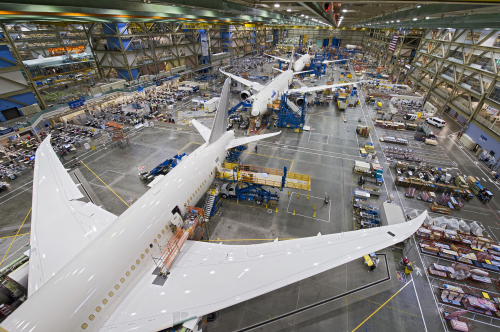
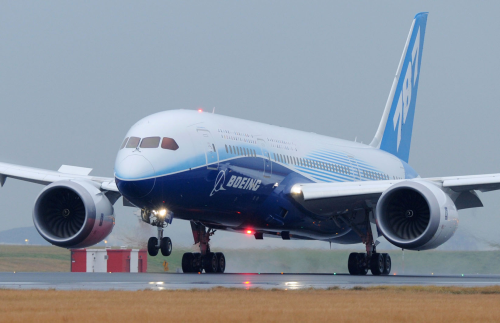
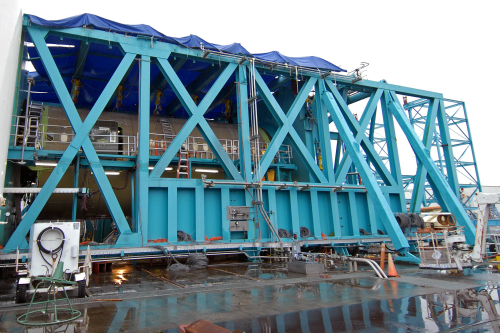
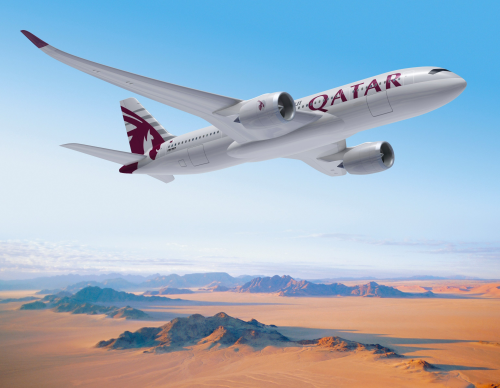
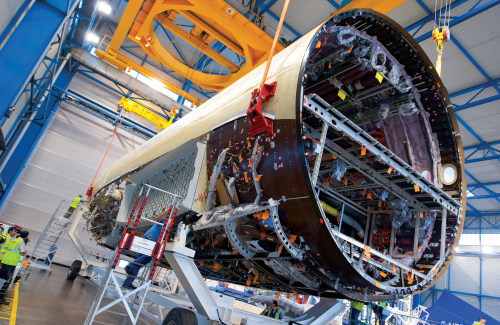
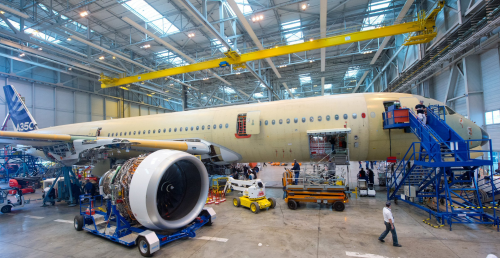
Flagships for this low operating cost revolution are Boeing’s B787 Dreamliner, now serving (with interruptions) several airlines, and Airbus’ A350 XWB contender for the same widebody twinjet market. These two aircraft families are expected to deliver major performance and efficiency gains, much of this improvement being due to the role of reinforced plastics in making airframes lighter and more aerodynamic.
Aircraft operators are crying out for jets that reduce operating costs and these latest half-plastic planes, plus other aircraft currently in development, promise this benefit.
The B787 first flew in December 2009 and the A350 XWB is expected to make a maiden flight this summer.
B787 Dreamliner
| Inevitably, it seems, radical innovation brings wobbles in its wake and Boeing has had more than a few of these with the B787. |
Inevitably, it seems, radical innovation brings wobbles in its wake and Boeing has had more than a few of these with the B787 (see Boeing's 787: trials, tribulations, and restoring the dream).
First there were the difficulties of bringing a large composite airframe into production – the fasteners issue, the complex multinational supply chain that resulted in ‘travelled work’ (i.e. work left uncompleted by sub-contractors so that items had to be finished after their delivery to the airframer), weight issues, the challenge of ramping up to series production, etc. – that we have outlined in previous Reinforced Plastics articles. Essentially, planners had under-estimated the difficulty for all concerned in transitioning from traditional metal airframe construction to a successor that is half plastic. Boeing resorted to extreme measures, including taking previously sub-contracted work back in house and even acquiring certain sub-contractors entirely. There were other troubles including an electrical fire, an engine failure and a labour dispute that delayed the programme.
More recently, however, it seemed that the Dreamliner was waking from its nightmare. Launch airline customer All Nippon Airlines (ANA) eventually received its first B787 in September 2011 (see Boeing celebrates delivery of first 787 Dreamliner) and ran its first commercial service with the type on October 26th. Japan Airlines (JAL) followed, accepting its first 787 in March 2012. Qatar Airways displayed its first B787 at the Farnborough Air Show in July 2012, before accepting formal delivery the following month. In the US, United Airlines has received six of the type.
Passenger response to the airliner has been generally positive. Meanwhile, however, there have been technical concerns – a brakes problem, oil and fuel leaks in the engines, cracked windscreen, electronic and software faults etc. These prompted the Federal Aviation Adminstration (FAA) to announce, on January 11th, a review of the aircraft’s critical systems (see FAA review for Boeing 787 – updated 16 January). Then came a shock setback that resulted in a complete grounding of the fleet of 24 aircraft so far delivered to Japan, subsequently followed by an FAA-imposed grounding of all US-delivered 787s also. Although the cause of the groundings was not composites related, it is worth outlining the nature of the problem which, at time of writing, is still on-going and has impacts on the supply chain.
Mystery
| Part of Boeing’s radical agenda for its new airliner was to adopt an ‘all-electric’ architecture in which control surfaces and other systems that have traditionally been operated hydraulically are now actuated electrically. |
Part of Boeing’s radical agenda for its new airliner was to adopt an ‘all-electric’ architecture in which control surfaces and other systems that have traditionally been operated hydraulically are now actuated electrically. Powerful batteries are needed, not least to start the auxiliary power unit (APU), the small engine in the tail of the aircraft that provides power when the main engines, and the attached generators, are not running and ground power is not available. For these batteries Boeing adopted an advanced lithium (Li)-ion chemistry, lithium-cobalt oxide, chosen for its high energy density. But, despite extensive development and testing before the first aircraft ever flew, there have been instances of these batteries over-heating and even reportedly catching fire.
A single reported fire occurred on 7th January this year on a JAL B787 when it was on the ground at Boston Airport, USA. This was followed eight days later by a battery overheat incident on an ANA B787 in flight. When smoke was detected inside the aircraft, the pilots elected to make a precautionary landing and an emergency evacuation followed. In this second incident a short circuit had occurred in one of the battery’s eight cells and the ensuing thermal chain reaction had caused the smoke and the conditions for a fire. The possibility of a fire aboard an aircraft is an absolute ‘no no’ and after this second significant event the FAA had little choice but to order the six B787s delivered in the US to be grounded. The Japanese had already grounded theirs and authorities in Chile and India followed the US decision. The turn of events was an embarrassment given that the FAA had previously certified the Dreamliner and its systems as airworthy. Deliveries of new aircraft were halted, though production has continued.
So far (as of early April) Boeing, Rose Electronics/Kokam responsible for the battery, the FAA and the National Transportation Safety Board in the US plus Japan’s Transport Safety Board remain unclear as to the precise cause of the problem. It is well known that lithium-ion batteries are sensitive to charge/discharge conditions and can overheat if certain parameters are exceeded. (Some owners of lap-top computers and mobile phones have experienced this and an air freighter crashed following suspected thermal runaway and a fire in a cargo of Li-ion batteries). In a large multi-cellular battery, if over-heating should spread from an initial faulty cell, cascading to adjacent cells, the ensuing thermal runaway is hard to arrest and can lead to a fire which is difficult to extinguish. Boeing and its contractors thought they had prevented all possibility of this happening with careful system design, but evidently they were mistaken.
Boeing is now implementing a fix that involves increasing inter-cell spacing, inserting ceramic plates between the cells, providing a stainless steel battery enclosure and adding a venting system to prevent smoke reaching the cabin. In March, almost two months after the grounding decision, the FAA granted Boeing clearance to flight test the proposed redesign on two of the flight test aircraft, following extensive tests on the ground. Should those tests prove successful in leading to recertification, Boeing will have to modify main and APU battery installations on the 50 or so aircraft already delivered, a task estimated to take four to five days per aircraft. The changes would also become part of a revised production standard.
Critics point out that the remedial measures may prevent cascading thermal runway and fires, but do not address the root cause of the problem. By early April that cause remained a mystery and investigations were continuing. Boeing has always stood by its battery choices despite some experts suggesting that it might have to change to an alternative Li-ion chemistry or, in the extreme, revert to a previous battery generation, nickel-cadmium (NiCad). (Ironically, NiCad batteries themselves were involved in thermal runaway events a decade ago when they were coming into aircraft use.) This would require a redesign and re-certification effort as well as incurring weight and space penalties.
| A delay of months inevitably has consequences for the composites community. |
A delay of months inevitably has consequences for the composites community. Delivery schedules are impacted since not all the 75 deliveries of the baseline B787-8 model originally expected for this year will take place. Certain airlines, such as the UK’s Thomson Airways, are having to delay service entry. Induction of the larger B787-9 variant into Boeing’s production system could be delayed while, similarly, the launch of the double-stretched B787-10 could be postponed beyond the Paris Air Show in June, contrary to earlier hopes.
A350 XWB
Meanwhile, Airbus has the luxury of learning from Boeing’s mistakes and misfortunes as it engineers its A350 XWB competitor. Its approach is, in any case, less radical. For example, it uses composite panels for the fuselage rather than the monolithic wound barrel sections espoused by Boeing, and has gone ‘more electric’ rather than ‘all electric.’ Also, it has a less extended supply chain than that put together by Boeing, with more of it being under its own control. (See Airbus takes on Boeing with composite A350 XWB.)
Interestingly Airbus has, like Boeing, specified lithium-ion for its contender’s batteries, though with less onerous duty cycles than those adopted for the 787. Chief executive Fabrice Bregier says he believes the A350’s electrical design to be ‘robust’ and, in the absence of further information, sees no reason to change it. However, it is believed that backstop consideration of NiCad batteries is also taking place.
In 2012 the A350 progressed well. The final assembly line became operational at Toulouse and the structural assembly of the first flying prototype, MSN1, was accomplished. This aircraft is due to fly later this year, though there is some doubt that this will be in time for the Paris Air Show. In January, the final assembly line disgorged MSN1 in almost structurally complete condition. Since then, this first aircraft has been undergoing certain indoor tests, now followed by outdoor ground testing (see First A350 XWB emerges for outdoor testing). Both Rolls-Royce Trent XWB engines earmarked for the prototype have been delivered to Toulouse for integration into the airframe.
The next major stage will be an intensive flight test programme. This will involve five aircraft, three of which will fly without their cabin interiors fitted while the other two will have their cabins complete so that interiors can be part of the test regime. All being well, the flight test phase will lead to certification and this will enable the aircraft to enter airline service. Launch customer Qatar Airways is expected to receive its first A350 in mid-2014 and introduce it into passenger service soon afterwards.
| Notwithstanding its visible progress, the A350 programme has not been without its problems. |
Notwithstanding its visible progress, the A350 programme has not been without its problems. An automated drilling process used at the wing making facility at Broughton, UK, did not initially work properly, forcing a reversion to manual drilling for the first two ship sets. This issue was resolved and wing production brought back on schedule late last year.
Other problems have been more routine so that production delays have not so far been excessive. One programme milestone was the parading last autumn of the first vertical stabiliser (tail fin). This 10 m tall composite structure was manufactured at the Airbus factory at Stade, Germany, and painted at Toulouse. The next A350 has been taking shape on the Toulouse production line. Airbus’ cavernous Beluga transport flew the three major sections of its fuselage there and these were joined together early this year. The fuselage sections overlap by a mere 8 cm and several thousand holes are drilled for the join-up. Another airframe on the line is intended for static structural test and will never fly.
With more than 600 A350s having been ordered to date, the Airbus product looks set to bring major business to the supply chain well into the future. Hexcel carbon fibre prepreg is used to manufacture the aircraft’s fuselage panels, keel beam, wing and empennage. The company’s estimated total content on each A350 XWB aircraft is expected to be over US$4 million (see Hexcel's composites ready to fly on the A350 XWB). To cite another supplier example, Virginia-based contractor ATK has contracts through to 2027 to provide low-weight composite fuselage frames and stringers. ATK uses proprietary stiffener forming machines to produce dimensionally precise and highly repeatable components in an automated process that avoids hand lay-up – an example of the progressive mechanisation of aerospace composites production that airframers require for economic, quality and timescale reasons.
Rolls-Royce’s new engine for the A350, the Trent XWB, has already flown, albeit on an A380 superjumbo. The first outing took place on the Airbus flying test-bed early in February, starting a flight test programme for the engine and its systems. Some 175 flying hours are scheduled, about three times more than on previous programmes, prior to MSN1’s maiden flight. This should ensure ready integration and a degree of maturity by the time the prototype starts on its own extensive flight test phase. The Trent XWB has significant composite content, most notably the fan blades and containment casing. (See Aero engines lose weight thanks to composites). ♦
- Part 2 of this article will be available on ReinforcedPlastics.com soon.
This article was published in the May/June 2013 issue of Reinforced Plastics magazine.
The digital edition of Reinforced Plastics is distributed free of charge to readers who meet our qualifying criteria. You can apply to receive your free copy by completing the registration form.
